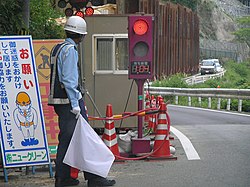 Japanese traffic guard | |
| Occupation | |
|---|---|
| Names | Flagger, Traffic Controller, Traffic Marshall/Traffic Marshal |
Occupation type | Employment |
Activity sectors | Traffic, Security |
| Description | |
Related jobs | Traffic Police, Security Guard |


Traffic guards, also known as traffic controllers, traffic marshalls/traffic marshals or flaggers, are trained to set up warning signs and barricades to slow down the speed of traffic in a temporary traffic control zone. When they are on scene they will set up equipment to warn approaching traffic about the incident. [1]